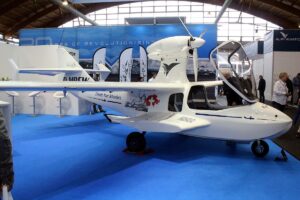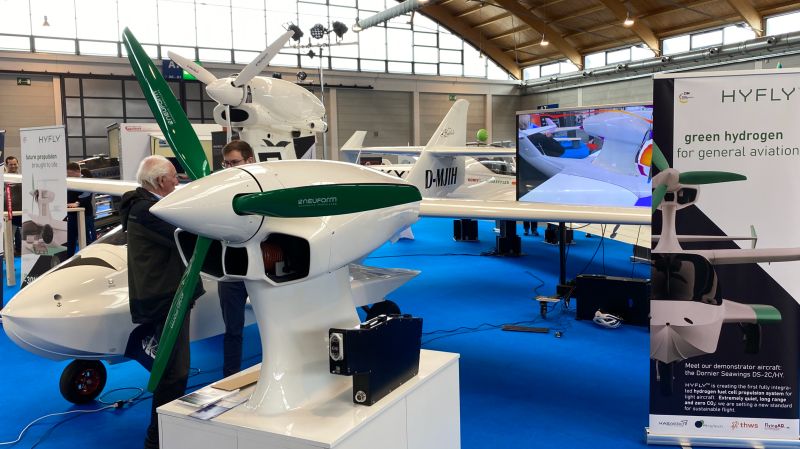What happens when a major aircraft company buys an interesting seaplane and repowers it with hydrogen? Dornier, a long-time German producer of often brilliant aircraft, acquired the rights to a two-seat amphibian, the Flywhale FW650, as of January 1, 2022. Originally powered with a Rotax engine, the craft will be repowered with an electric motor and a variety of possible battery, hydrogen, or hybrid power sources.

Dornier’s newly acquired Flywhale, designated the DS-2C and soon to be converted to hydrogen power
Redesignated the Dornier DS-C2, it becomes part of the Seawings division and could live not only in the world of unlimited runways, but become a true eVTOL (electric Vertical Take Off and Landing) airplane, the DS-2C-X.
The standard Light Sport Aircraft configuration can carry two at 250 kilometers per hour (155 mph), over a distance of 1,000 kilometers (620 miles) – impressive enough.
It can operate in sea states up to 2 (Sea state 2 includes waves of 0.6 to 0.9 feet and winds up to 8 to 10 knots, or 9.2 to 11.5 mph.)
Dornier is joined by a small group of specialists to make the project come clean. HyFly promises green hydrogen for general aviation. PS HyTech brings lightweight H2 containment vessels and connections. Kasaero, proficient on projects such as Eviation’s Alice and the Junkers A50 Junior, lends its expertise in multiple disciplines. With support from the Technical University of Applied Sciences Würzburg-Schweinfurt, the consortium has added academic credentials to its mix.
HyFly
The consortium of private enterprise and academic, HyFly, “is creating the first fully integrated hydrogen fuel cell propulsion system on light aircraft. It delivers quiet, long-range operation and zero CO2 emissions, setting new standard for sustainable flight.”
The propulsion system comes from Kasaero GmbH, THWS Schweinfurt, and PS-HyTech. The “Completely new type of system” will enable electrically powered ultralight and small aircraft “to fly long distances just as easily as modern machines with combustion engines and only emit steam.”
The almost dream-like quality of that goal, coupled with the promise of a takeoff weight equal to that of the piston-powered craft and multiples of its range, also reduces the risks of overheated lithium-ion batteries in the air. A shown here with a Rotax-powered Flywhale, the performance would apparently equal most LSAs.
Karl Kaeser, CEO of Kasaero GmbH, describes the tasks of the thirty people in his employ, “Our engineers are constantly working on the miniaturization of mechanical and electronic components and combine this in the new and further development of aircraft with the improvement of aerodynamics and fuselage / wing construction.”
PS HyTech owner Peter Stadhalter explains his “very light tank” for hydrogen storage. It currently stores H2 at 700 bar, or 10,105 pounds per square inch pressure. “Our goal for the next two years is now to reduce the weight of the fuel cell system and the control technology by 90% and to save at least 80 kg in weight compared to an electric drive system with pure battery storage!” This type of performance would make Klaus Ohlmann’s vision of emission-free flight a reality. Remember e-Genius was originally intended to be HydroGenius, an H2-powered craft. It and its Green Flight Challenge rival, the Pipistrel G4, are headed toward hydrogen power, with the H4, as it’s now called, flying its first load of liquid hydrogen recently. In the meantime, Klaus is test-flying the E-Rop, a potentially H2-powered Antrares sailplane.
Stadhalter expands on the idea, noting his design reduces specific tank weight from 15 kg per kg of hydrogen to a ratio of 5: 1. “This is a real quantum leap.”
PS HyTech’s web site provides further reassurances. “The greatest hazard potential of hydrogen comes from the mechanically stored pressure energy in the 700 bar tank. If a tank with a volume of 250 l (this corresponds to 10 kg of hydrogen or 200 kWh of drive energy or 10 hours of flight time) actually bursts, this only corresponds to the explosive force of around half a liter of gasoline in an ignitable mixture. The safety concept for aircraft includes fast tank emptying in emergency situations, triggered independently by rescue systems. This makes the tank pressureless and safe in the event of a fall.
DS-2C-X-eVTOL research project
Beyond a mere amphibious light sport aircraft, Dornier sees a leap into the DS-2C-X-eVTOL, the world’s first amphibious eVTOL..
Dornier is in good company with the HyFly project, hoping to explore “the ideal configuration and power supply, including:
- “Fully battery electric
- “Hybrid Electric
- “Hydrogen Electric
- “Hybrid using alternative fuels
With so many options available and so many developers pushing toward emission-free flight, we can see green skies ahead. Think of ultralights and LSAs that can perform without a battery weight penalty or frustratingly limited endurance and range. This could become interesting.

